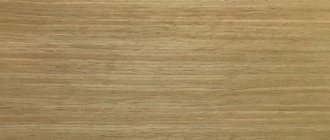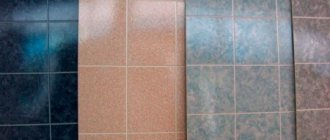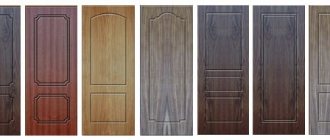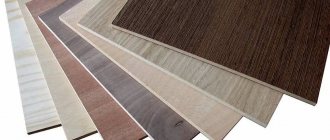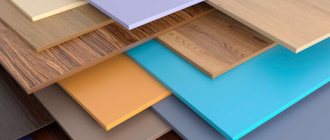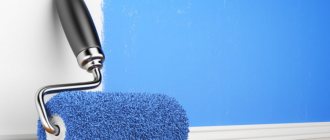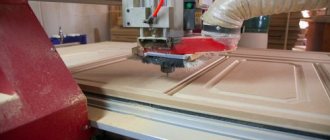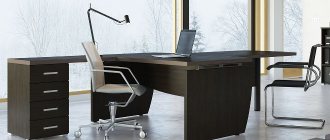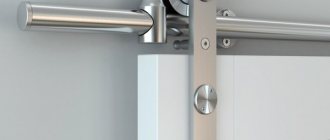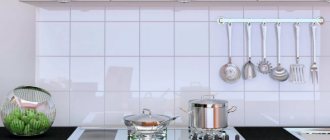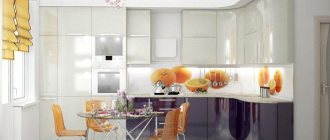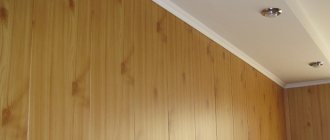If MDF surfaces have to constantly come into contact with water, then this can have a very detrimental effect on them. Therefore, before covering something with MDF, you should think about whether this material needs additional protection.
You can protect MDF from moisture using various means. Drying oils, such as PVA glue and vinyl film, have proven themselves to be good for these purposes. Let's consider each of the above methods for treating MDF from moisture.
Protecting MDF with drying oil
Perhaps the most inexpensive way to treat MDF so that the boards do not rot during use is to apply drying oil to their surface. It would be advisable to note that this method of protection is applicable only in cases where MDF is used as flooring for leveling floors.
In this case, special attention is paid to the ends of the MDF and the seams between them. It is better to treat these areas with drying oil several times, since they will absorb it very well.
Processing MDF with PVA glue
Protecting MDF with PVA glue is applicable precisely in cases where the ceiling or walls are sheathed with slabs. It is a known fact that PVA glue has good performance in terms of water resistance and reinforcement. Therefore, MDF panels treated with PVA glue last much longer.
As with the first method of protection, PVA glue is applied to MDF with a brush in one or two layers. Before applying glue, dust and other contaminants should be removed from the surface of the boards so as not to disrupt the adhesion of the materials.
Gluing vinyl film to MDF
Previously, the construction magazine samastroyka.ru already talked about the positive aspects of vinyl film. This material can be used for various purposes, including to protect MDF surfaces from moisture.
Vinyl film can not only protect MDF from the harmful effects of water, but also significantly improve their appearance. As a rule, this method is perfect in cases where the slabs are used indoors.
Gluing vinyl film to MDF boards is quite simple. The main thing is that the surface of the panels is clean and free of dust. Vinyl film is not glued to the ends; for these purposes it is best to use special protective corners, like on furniture.
There are many different ways to protect MDF from moisture. The main thing is to choose the right one that is most suitable for a particular situation.
Photo report: Wood, MDF, chipboard and water.
The purpose of the experiment is to test the resistance of materials used in the production of doors to direct exposure to water, which is typical for short-term leaks in residential premises.
| 3 samples of materials were selected - solid wood, MDF and chipboard. measurements were carried out using calipers. |
| The geometric dimensions of the samples were measured. Then they were immersed 1/3 in water. The measurement results are given at the end of the publication. |
| Subsequently, samples were taken and control measurements were taken at various time intervals. The first measurement was taken after 15 minutes in the water. |
| The next measurement was taken after 45 minutes of being in the water. |
| Then after 1.5 hours. |
| They finally removed it from the water and took measurements after 3 hours of exposure. Time counter reset |
| We switched to natural drying mode. We took 2 measurements. After 4 hours of drying. The last one is in 14 hours. |
Results of sample size measurements.
| Time | Chipboard thickness * length | MDF thickness * length | Array thickness * length |
| Dry samples | 16.4*69.5 mm | 14.3*69.5 mm | 19.9*55.0 mm |
| 15 minutes in water | 17.0*69.7 mm | 14.5*69.5mm | 19.9*55.0 mm |
| 45 minutes in water | 17.5*70.0 mm | 15.0*69.6 mm | 20.0*55.5 mm |
| 1.5 hours in water | 18.0*70.0 mm | 15.2*69.8 mm | 20.3*56.3 mm |
| 3 hours in water | 18.5*70.0 mm | 15.5*70.0 mm | 20.5*57.0 mm |
| 4 hours drying | 18.7*70.0 mm | 16.1*70.0 mm | 20.5*57.0 mm |
| 14 hours drying | 18.8*70.0 mm | 16.0*70.0 mm | 20.3*56.4 mm |
Conclusions:
- Chipboard absorbs moisture most quickly and actively. MDF and solid wood are much more resistant to water.
- Swelling of MDF and chipboard continues even after the absence of water.
- After drying, MDF and chipboard practically do not decrease in volume, retaining residual swelling from water. The massif begins to more actively release moisture, its dimensions tend to the original ones, but the residual effect of water remains.
- Where the samples behaved identically when exposed to water was that none of the samples produced roots or young shoots.
Source: 5euro.ru
Risk area
And in order to prevent such a situation, it is important to follow simple steps during assembly. First of all, we protect the sink cabinet and the cabinet with the dish dryer; the modules are in direct contact with water. In the latter, it is advisable to install frame facades with grilles for air circulation.
The risk zone also includes cabinets with a dishwasher and washing machine. I recommend making the body of such modules from moisture-resistant material. If the situation does not allow this, then we will use a sanitary, transparent sealant. This is reliable protection from moisture in your kitchen.
How to coat MDF with varnish?
MDF varnish is used for decoration or to protect chipboards from moisture. In order for the coating to last longer, it is necessary to choose the right material. Existing types of varnishes differ in properties. Several techniques are used to apply the composition: wet and powder painting.
Post-treatment with wax
You will need it if you use natural oil, wax-free oil, or want to enhance properties, change texture or add color.
Compositions with natural beeswax or carnauba wax are suitable. Pay attention to the final color of the surface: if you choose darker shades than the natural color of MDF or HDF, whitish marks may appear on the surface due to mechanical stress. It is better to treat light or natural slabs with wax.
Wax or water-based oil are not suitable for processing MDF and HDF; they will cause huge consumption and at the same time leave the surface rough. It is also impossible to achieve moisture resistance using such compositions.
Advantages of varnishing
The varnish can ruin the coating of the panels (corrodes it). However, when applied carefully, this finishing method has several advantages:
- increasing the strength of particle boards, MDF becomes resistant to mechanical loads, and the likelihood of damage due to impacts is reduced;
- resistance to temperature influences increases, MDF does not lose its shape when the value of this parameter increases, thanks to this it becomes possible to place hot dishes on the surface of chipboards;
- varnish improves the external properties of the panels; there are compositions that allow you to obtain a glossy surface, pearlescent, matte and other types of materials;
- used for finishing surfaces inside and outside the object;
- the ability to maintain its original shape under the influence of moisture is retained, the panels do not swell;
- resistance to fungi;
- provides protection against chemicals;
- the varnished surface is easy to clean, partly due to the increased moisture resistance of the panels.
As a result, the service life of particle boards increases. They can be installed even for operation in difficult conditions: under the influence of high temperatures, with increasing humidity.
How to choose an effective moisture impregnation for wood?
In order for impregnation to give the maximum effect, it is recommended to familiarize yourself with the characteristics of the products offered and select exactly the material that best suits the specific type of wooden structures and their operating conditions. The main aspects to pay attention to include:
- depth of penetration of the product into the wood;
- environmental safety of wood impregnation against the negative effects of moisture, presence/absence of a pungent odor;
- place of application - for external or internal work;
- the degree of action of the composition on different types of fungus, mold and insects;
- material consumption - on average it should be up to 200–250 g/m²;
- validity period of the mixture.
When purchasing, you should take into account the climatic conditions of the area. If the house is located in areas with frequent precipitation, it is best to choose impregnations that effectively protect the wood during sudden temperature changes. For places with high humidity, it is advisable to take a water-repellent composition, the main function of which is to protect the wood from moisture.
What varnish should be used for MDF boards
Consider options that provide different effects:
The first of the materials includes acrylic components. Gloss varnish contains synthetic resins. It is recommended to coat MDF with two-component compounds. They are produced in separate containers. The substances are mixed before use. The result is a material characterized by suitable properties. They are used to varnish panels, but it is important to complete the work within the next 2-3 hours after preparing the solution. After this, the material loses its properties.
When choosing a varnish, a number of criteria are taken into account:
- recommended consumption – no more than 500 g per 1 m² (when applying 1 layer);
- concentration of volatile components in the composition – up to 20%;
- application conditions: +5…+25°С;
- the setting period of the composition is up to 15 minutes;
- Drying time: no more than 72 hours.
Yacht varnish is suitable for protecting MDF. There are several varieties of it. They differ in the degree of toxicity, which determines the possibility of using such materials inside the facility. For example, the alkyd composition is highly toxic, so it is not used to treat walls or furniture in the house. It is permissible to use alkyd urethane inside the object. This composition has properties that are important when processing particle boards.
The alkyd-urethane analogue, on the contrary, contains more volatile toxic components. This yacht varnish cannot be used inside the house. Acrylate does not protect against water exposure well enough, but it is environmentally friendly, so it is used inside objects.
Necessary tools for varnishing
The material sets quickly, so you need to prepare everything you need to work with it:
- container for creating the mixture (if a two-component composition is used);
- a construction mixer or a special attachment for an electric drill;
- spray bottle, brushes of different sizes (narrow and medium width), roller;
- devices for making ornaments: sponge, construction tape, stencil;
- solvent, when you need to dilute the varnish to obtain the required consistency;
- sandpaper of different grits for sanding the surface.
When choosing, the configuration of the structure being processed is also taken into account; if there are difficult areas, prepare a small brush. It is also used when the main tool is a spray gun or roller. A narrow brush will help to treat hard-to-reach areas and small details.
During work, use protective equipment: rubber gloves, a respirator. When MDF board is treated with varnish containing a high percentage of volatile toxic components, the respiratory tract is protected. Otherwise, the risk of poisoning by toluene and xylene vapors increases.
Proper installation of the sink will help keep furniture longer and in better shape.
To prevent dirt from accumulating around the sink and mold from forming, it must be installed correctly. | Photo: masterovoi.ru/ morediva.com.
How to treat chipboard for moisture resistance and wear resistance before laying it on the floor, processing the ends
Simple methods of processing sheet material include applying drying oil. This method is chosen when laying slabs before creating a rough floor screed. Drying oil is applied to the entire surface of the chipboard twice. The transverse edges of the sheets require treatment with drying oil at least three times.
Expert opinion
Strebizh Viktor Fedorovich, leading construction foreman
Packages must be stored in pallets in the position indicated on the handling symbols on the packaging label. If you want to clarify something, please contact me!
Dyeing technology
The final result of processing MDF depends on whether the sequence of actions was followed when applying the composition. Main stages:
- putty;
- primer;
- direct painting with varnish;
- drying.
First, the room and surfaces to be treated are prepared. Floors, walls and pieces of furniture located next to the surface to be treated are protected from varnish splashes. It will be difficult to remove such defects in the future. If you use a solvent for this, you can damage the furniture or the lining of the floor or supporting structures.
At the next stage, the surface that will be varnished is sanded. For this purpose, abrasive means for mechanical grinding or electrical equipment are used to speed up the process. The MDF surface is smooth. If you apply finishing material to an unprepared slab, the service life of the decorative coating will be reduced. To prolong it, abrasive agents are used.
Ceiling finishing
However, finishing work on the balcony is not limited to wall decoration. In addition to the walls, there is also a ceiling?
Most often, the ceiling is finished using the same materials as the walls, and insulated in the same way.
However, when finishing the ceiling you need to take into account some nuances:
- The space between the ceiling slab and the ceiling sheathing should be large enough to accommodate lighting fixtures.
- If the height of the balcony is small, then for finishing the ceiling it is better to use a material several tones lighter than the finishing of the walls. This technique visually increases the height of the balcony, and you will feel more comfortable in this room.
As you can see, there are several finishing options, and here we have mentioned the most common ones. So before you decorate the inside of the balcony with your own hands, spend some time studying the whole variety of materials - and you will definitely find what you need.
Reasons for the popularity of MDF among furniture manufacturers
MDF is the initial letters of the English expression Medium Density Fiberboard. The technology that is now used in the production of MDF is a refinement and improvement of the technology that was used for the production of fiberboard - fiberboard, made from the smallest fractions of sawdust. In the production of MDF, wood fibers are dried, bonded and formed into a board, which is treated with high pressure and high temperature. Paraffin and lignin are used as fastening elements. Lignin is a natural substance found in every tree. Lignin is obtained from wood by treating it at high temperatures. No harmful resins or phenol are used in the production of MDF. Based on the above, we can safely say that MDF is an environmentally friendly material. Among the main advantages of MDF are: – a sufficient level of softness, thanks to which MDF is very easily amenable to the finest processing, which makes it a favorite material for furniture makers and designers, as it allows the most daring decisions to be realized. Despite the fact that MDF is used in many industries, MDF is mainly used as a furniture material. – despite the fact that MDF has adopted all the advantages of wood, it costs several times less. – the service life of products made from MDF is many times longer than the service life of products made from solid wood.
One of the disadvantages of furniture MDF is the lack of production of this material in our country.
As already mentioned, MDF is used in many areas, but in the furniture industry it is used especially actively and there are many reasons for this. In the production of furniture, mainly solid wood, fiberboard (fibreboard) and chipboard (chipboard) are used. All these materials are practically unsuitable for painting.
Wood is an excellent natural material, it can easily be processed through the finest treatments, but it does not tolerate moisture, it dries out and cracks. Under varnish, cracks in the wood are not noticeable, but under paint, especially light paint, they will immediately catch your eye.
Chipboards (chipboards) are a fairly strong material, excellent for painting, but cannot withstand moisture and cannot be milled. Wood fiber boards (Fiberboard) are a very thin material, they are processed with great difficulty, do not tolerate moisture, and cannot be painted evenly.
Furniture MDF lends itself perfectly to the finest processing, milling and sanding. Furniture MDF can be perfectly painted. Finished products made from MDF furniture do not warp, crack or dry out. MDF, having all the positive qualities of wood, is completely devoid of the disadvantages that are inherent in wood: low density, heterogeneity, the presence of knots, and a tendency to rot. In the production of MDF boards, adhesives containing formaldehyde are not used, therefore furniture made from MDF has received permission for use in children's institutions, hospitals and in those premises that require a high degree of protection from the external environment. Furniture MDF is a universal material, therefore it is widely used for the manufacture of furniture for offices and for the home; doors, countertops, window sills, floors, baseboards, suspended ceilings, packaging, containers, toys for children, school supplies and much, much more are made from it.
Base material
Thanks for the answer. I would also like to know if there are any special features in using MDF? For example, what is the best glue and tape to use, whether MDF is glued and if so, then with what, relation to acrylic (varnish, primer), etc.
From experience working with MDF: (I’ll tell you right away to use this surrogate only if absolutely necessary) pavolok is not needed, gesso is used only as a light primer, there is no need to scratch it with anything - a flat surface is ideal for work. Ready-made artistic primer with pre-impregnation is better suited acrylic (if the primer is acrylic).
MDF can loosen over time, it is afraid of moisture, its density is greater than that of a natural board, so it is heavier.
Moreover: you can use ready-made Greek gesso on canvas as a primer - this is just suitable for perfectly flat surfaces.
Guest I'm very interested, could you please clarify some details, namely:
This means that this is obviously a bad thing, but what qualities make it so?
What is acrylic in its pure form, suitable for impregnation? Is it possible to quote some label, otherwise I don’t know what to look for?
Do you mean rolled primed canvas that is glued to MDF? What kind of glue? Does this make MDF more suitable for work?
Again, can you provide the label?
MDF is a good idea, but it was implemented without taking into account open use, i.e. MDF is subsequently covered with various laminates for furniture use. I will not describe how MDF is produced - detailed technical descriptions can be found on the Internet. https://shkafy-kupe.ru/articles/materials/mdf.htm, etc. The main disadvantage of MDF is the weak connection between small wood fibers. Destruction usually begins at the corners of the MDF board. If the process has begun, then everything will crumble into fine dust. You can seal it with varnish, preferably acrylic - it’s more reliable. MDF is best suited for small jobs. I will answer in more detail: MDF board is mainly obtained by pressing under high pressure. If we make a large board more than 2 meters high and place it, then at the very bottom there will be excess stress on the internal structure of the material. Small MDF particles under constant pressure begin a gradual reverse movement obtained during production under pressure - the lower edges are gradually loosened and destroyed. That’s why small parts for furniture are made from MDF, and always for laminate, which keeps the pressed mass within the framework that was originally given to it.
An ordinary construction acrylic primer - a milky white liquid - is quite suitable for impregnation.
No, MDF does not become better with any processing option. Its disadvantages are inherent in the production.
Last edited by: Victor Demidov (30 Dec 2006 01:57), edited 1 time in total
Victor Demidov Thank you for your detailed answer.
In this case, can double-sided burlap covering play the role of a laminate? (With primer, of course, on the front side)
I heard somewhere that PVA and acrylic cannot be used together, is that true?
Are there any analogues to MDF in this price category - for example, chipboard or fiberboard? What are their weaknesses and strengths compared to MDF?
Victor, it seems to me that you are exaggerating a little about the fragility of MDF. Its closest relative is the well-known hardboard, fiberboard. Its operational properties have been well known to all of us for decades. MDF differs in manufacturing technology in that higher pressures are used when pressing it, which gives greater strength and resistance to changes in humidity compared to fiberboard. Ruthenium I said about fiberboard above, but particle boards (chipboards) are a thing of the past; they are inferior to MDF in many respects, of which strength and durability are the main ones.
Victor, what can you say about gypsum board as a basis for painting?
Burlap - ? – why make it so complicated? In this case, it is better to paint with oil paint.
I drew a diagram of the action of destructive pressure in a slab when installed vertically. As you can see from the picture, the bottom corners and the bottom end itself are very critical here; this place (more precisely, the bottom end) can and should be covered with burlap.
I heard somewhere that PVA and acrylic cannot be used together, is that true?
Read more carefully, I talked about acrylic impregnation for acrylic art primer and about PVA glue for gluing ready-made gesso. Of course, there is no need to mix these things; they have different film formation. If you glue on PVA, then make the preliminary impregnation from PVA
50% pva + 50% water. PVA is better than American, the color of baked milk. But PVA has a limited service life in the product.
We didn’t work with chipboard and fibreboard, so I can’t say anything about these materials.
mdf2.jpg 5.28 KB • 171
Pressure in the MDF board during vertical installation.
Posts 1 page 17 of 17
Share114-08-2015 10:52:47
- Author: Georgik
- New guy
- From: Krasnodar
- Registered: 11-08-2015
- Invitations: 0
- Posts: 9
- Respect: [+17/-0]
- Positive: [+0/-0]
- Gender: Male
- Age: 46 [1973-06-16]
- Time spent on the forum: 3 hours 34 minutes
- Last visit: 01/30/2017 16:09:29
Is it possible to make MDF moisture resistant so that the material works in a really humid environment, in direct contact with water? It is planned to glue several sheets and then profile them with a milling cutter. I’m thinking of soaking it through with diluted varnishes and resins and also gluing it with resin or waterproof glue. Polyester, which was recommended in the next topic about gluing, is not suitable - it is not moisture resistant.
Share214-08-2015 11:01:57
- Author: solohan
- Local
- From: Krivoy Rog
- Registered: 08/19/2011
- Invitations: 1
- Posts: 199
- Respect: [+14/-0]
- Positive: [+44/-3]
- Gender: Male
- Age: 49 [1970-07-03]
- Time spent on the forum: 18 days 21 hours
- Last visit: 22-10-2018 13:41:37
about 10 years ago we sold an insulating agent from Barpimo, they positioned themselves by the fact that a part treated with it would lie in water for a day without harm, we used it when it was necessary to put nitro or polyurethane on acrylic
Share314-08-2015 16:29:03
- Author: UserUfa
- Interested
- Registered: 04/20/2015
- Invitations: 0
- Posts: 26
- Respect: [+18/-0]
- Positive: [+6/-0]
- Spent on the forum: 1 day 13 hours
- Last visit: 03/24/2020 12:59:45
about 10 years ago we sold an insulating agent from Barpimo, they positioned themselves by the fact that a part treated with it would lie in water for a day without harm, we used it when it was necessary to put nitro or polyurethane on acrylic
As I understand it, this information is not relevant now. Their website hasn’t been updated for two years, but are there any analogues in Russia?
Share414-08-2015 16:36:10
- Author: solohan
- Local
- From: Krivoy Rog
- Registered: 08/19/2011
- Invitations: 1
- Posts: 199
- Respect: [+14/-0]
- Positive: [+44/-3]
- Gender: Male
- Age: 49 [1970-07-03]
- Time spent on the forum: 18 days 21 hours
- Last visit: 22-10-2018 13:41:37
Share514-08-2015 16:43:18
- Author: Georgik
- New guy
- From: Krasnodar
- Registered: 11-08-2015
- Invitations: 0
- Posts: 9
- Respect: [+17/-0]
- Positive: [+0/-0]
- Gender: Male
- Age: 46 [1973-06-16]
- Time spent on the forum: 3 hours 34 minutes
- Last visit: 01/30/2017 16:09:29
They have a lot of products on their website, but I couldn’t find them directly.
I called the representative office. They cannot recommend a specific product, because... we need to check everything. The best result may be with polyester resin
Edited by Georgik (14-08-2015 16:51:10)
Share614-08-2015 18:40:28
- Author: sovest77
- Local
- From: Cheboksary
- Registered: 05-02-2013
- Invitations: 0
- Posts: 154
- Respect: [+7/-0]
- Positive: [+142/-0]
- Gender: Male
- Age: 42 [1977-12-14]
- ICQ: 11436395
- Time spent on the forum: 11 days 14 hours
- Last visit: 14-02-2020 16:58:46
Alternatively, you can do the same with stabilized wood by impregnation in a vacuum.
Share714-08-2015 18:44:39
- Author: Georgik
- New guy
- From: Krasnodar
- Registered: 11-08-2015
- Invitations: 0
- Posts: 9
- Respect: [+17/-0]
- Positive: [+0/-0]
- Gender: Male
- Age: 46 [1973-06-16]
- Time spent on the forum: 3 hours 34 minutes
- Last visit: 01/30/2017 16:09:29
not an option - this is what kind of chamber is needed, what kind of vacuum pump. It’s easier to soak, glue, dry and mill.
Share815-08-2015 13:28:09
- Author: sovest77
- Local
- From: Cheboksary
- Registered: 05-02-2013
- Invitations: 0
- Posts: 154
- Respect: [+7/-0]
- Positive: [+142/-0]
- Gender: Male
- Age: 42 [1977-12-14]
- ICQ: 11436395
- Time spent on the forum: 11 days 14 hours
- Last visit: 14-02-2020 16:58:46
not an option - this is what kind of chamber is needed, what kind of vacuum pump. It’s easier to soak, glue, dry and mill.
Well, you can use any vacuum cleaner (even from table pressure), but as for the camera, yes (((. for the most painful issue, more than 300x300 is simply not possible. The vacuum is 25 liters dry. But 0.8 holds after 3-5 minutes
Share915-08-2015 15:44:30
- Author: Trudyaga
- Local
- From: Kyiv, Ukraine
- Registered: 07/26/2014
- Invitations: 0
- Posts: 155
- Respect: [+125/-2]
- Positive: [+85/-0]
- Gender: Male
- Age: 41 [1978-05-04]
- Spent on the forum: 5 days 20 hours
- Last visit: 12-11-2018 22:34:16
Is it possible to make MDF moisture resistant?
And good luck to you too. It is not only the product you will cover that is important, but also how you will do it. The end of the sheet is also milled; it’s not even a sponge that absorbs moisture, it’s just a water absorber. Therefore, treat such places manually with a brush, apply so many layers so that the surface shines after a stroke. (that is, you smeared it once, the material was instantly absorbed, as if it had not been there, the second time you applied it, it was already a little noticeable that something had been applied, the third time the surface was matte but not so matte, the fourth time, etc. until it began to shine) Apply the insulator You can, of course, use Borpimo, Sayir Lak and IKA, whatever is at hand. But if there is none, then with the specified processing method, you can apply an acrylic product (any) in 3 repetitions of the operation. The main thing is that during operation the applied layer is not damaged mechanically. Make a sample and throw it into the water. Usually moisture is picked up at the poorly processed end. Peace and goodness to you.
Composition, advantages and purpose of plates
MDF is wood fiber board. They are environmentally friendly material and have medium density. This material has gained great popularity due to its characteristics and properties:
- MDF panels have a high level of moisture resistance. They do not deteriorate when exposed to moisture.
- Good resistance to high temperatures.
- Strength.
- Affordable price. This building material is much cheaper than natural wood.
- Resistance to fungi and microorganisms.
- Easy to care for.
- Possibility to produce products of any shape.
- MDF can be coated with special varnishes, paints, and enamels.
Most MDF panels are used in the furniture industry. Office and home furniture, commercial equipment, and doors are made from them. They are also used for the manufacture of facades, countertops, acoustic systems and other things.
Installation
There are several options for mounting MDF panels:
- on a specially installed frame;
On the frame
- on glue.
On glue
It is the second method that is more popular; it is less time consuming. The only important nuance is landing on a perfectly flat wall, so you will have to prepare everything in advance.
The entire process of gluing panels is divided into several steps:
- exact knowledge of the meters in the room where the panels are planned to be glued. This will help minimize waste;
- preliminary adjustment of all parts of the decor. This will make it easier for you to decide and place all the pieces in the right places for later gluing;
- the next step is to attach the starting molding in the right places;
- Now you can glue the panels according to the order. Here's how to glue MDF to a wall. The glue layer must be thin and uniform to avoid defects. It is applied in thin strips evenly spaced from each other;
- All joints and junctions of MDF for the ceiling must be hidden behind pre-prepared panels.
Another option is to use lathing, thereby leveling the walls for subsequent fastening of the panels using self-tapping screws.
For more information about installing MDF panels, watch the video:
Why varnish
Coating MDF panels with varnish is required quite often. Why? There are several reasons.
- The varnished surface easily copes with increased ambient temperatures. For example, you can place hot dishes on a varnished table made of MDF.
- Using varnish you can create various decorative effects. It can be glossy, matte-silky surface, mother-of-pearl, etc. It is noteworthy that similar effects are used for both interior and exterior decoration.
- High-quality varnishes will not make MDF panels less environmentally friendly.
- The coating significantly increases the service life of the product.
There is one drawback. Varnished or painted structures/slabs are more expensive than regular ones.
How to treat lining inside a house: what impregnation to choose
- products intended for hanging on walls . Please note that in most cases, manufacturers complete this type of product with fittings for fastening to concrete surfaces. In other cases, you will need advice;
- products with glass shelves, mirrors or doors . Please be aware that handling mirrors and glassware with cracks poses a risk of injury. Therefore, if a crack appears, be sure to replace the damaged element;
- cabinets and cabinets . To prevent these products from tipping over, it is prohibited to simultaneously pull out all the drawers or open all the doors when the product is empty (unfilled with items). As a rule, the door opening angle is no more than 90°;
- a bed with an orthopedic frame without a mattress. In addition, in order to avoid breaking the slats of the elastic base of the bed structure, sudden impact loads are undesirable.
How to coat fiberboards
A special varnish is used to treat surfaces. It helps create a smooth coating that is resistant to mechanical and chemical influences. The treated surface can be glossy or matte. Gloss is the result of using varnish based on synthetic resins. A water-based acrylic coating gives a matte effect.
MDF coating varnish is a two-component substance. Before starting work, you need to add a hardener to the base. Typically this varnish is odorless.
The prepared working mixture should be used within two to three hours. The coating can be applied using a spray or a regular brush.
Like all finishing materials, varnish for MDF panels has its advantages and disadvantages. In addition to the fact that it has good moisture and heat resistance, it protects the material from the appearance of fungus and harmful microorganisms, creating a dense film on the surface of the slab. The varnished surface is easy to clean, does not wear out, and retains its good appearance for a long time. By covering a product, for example a door, with a varnish composition, you can emphasize the texture of the base and give it a certain shade.
If the texture of a wooden product needs to be hidden or given a different color, MDF is often painted.
The disadvantages of varnish coating include its fire hazard, drying time, fairly high price and increased consumption.
When choosing a varnish to coat MDF panels, you need to pay attention to some parameters:
- drying time should not exceed 72 hours;
- dust drying time – no more than 15 minutes;
- operating temperature – from +5 to +25 degrees;
- the composition of the varnish should contain no more than 20% of volatile substances;
- consumption no more than 0.5 kg per square meter.
Types
A wide selection of MDF panels allows you to choose the decor that suits your idea. It is worth highlighting the main types.
Tiled
The different shapes and sizes of the slabs make it possible to translate even the most unexpected design solutions into reality, thereby creating a unique interior.
In the form of slats
Their sizes are also different, which also contributes to the implementation of an unusual idea.
You just need to first install an additional grille on which the panels will be attached.
This is usually a wooden or metal base, depending on your preference.
In the form of slats
Special brackets are attached to the mesh using self-tapping screws. Very effective if you need to decorate a small room.
Leafy
The sheet type of panels is used for covering large rooms. The large size of the sheet allows you to finish the walls of the room in a short time. The main convenience is the ability to attach MDF sheets to glue. The structure and form are chosen by the customer.
There are also different options for processing the surface layer of MDF sheets. You need to know which panels can be used for finishing more humid rooms.
Liminate
Laminated panels - this type of MDF is distinguished by the fact that a special PVC film is applied to the top layer. The design wonderfully imitates wood, stone or metal. The advantage of this type is dust-repellent property in addition to water-repellent.
Veneered
Veneer panels also imitate any wood, thanks to the veneer covering the surface of the sheet.
Veneered
Covered with paint
Panels coated with paint use special dyes in the solution, due to which the panel acquires an unusual and attractive appearance, and in addition also protection from external factors.
When choosing a suitable MDF material for yourself, pay attention to its characteristics and which finishing building material is best for you.
Covered with paint
The working process
Before you start varnishing MDF structures, you need to prepare tools and additional materials:
- Tassels. You will need 2 pieces. One (narrow), with which you can paint small parts, and the second (medium) - for painting the remaining parts. An alternative is a roller or spray gun.
- Container for mixing components.
- A drill with a special attachment or a construction mixer.
- Working capacity.
- If there is a need to apply a design or ornament on the door, you need to prepare tape, stencils and a sponge.
- Sandpaper.
- Gloves.
- Solvent.
It is advisable to cover the workplace with paper and prepare a stable stand for the doors in advance.
Operating procedure
Before varnishing, you need to apply a layer of primer. For what? Firstly, the primer finally cleans the surface of dust and small debris. Secondly, it helps to avoid unnecessary consumption of the working mixture. Thirdly, it improves the absorbent properties of the material. And, fourthly, it makes it possible to make the coloring more uniform. Also, thanks to the primer, minor damage to the door leaf can be detected.
The workflow consists of several stages:
- First you need to apply a layer of primer;
- use putty to cover up small cracks, scratches and chips;
- walk over the surface of the doors with sandpaper;
- prime again;
- using a brush, apply varnish to the ends, design lines and other inconvenient places;
- use a brush, roller or spray gun to paint the main part of the door;
- if necessary, apply a second coat of varnish.
Nuances
- You should not skip the surface preparation process, in particular grinding.
- Before use, the mixture of varnish and hardener must be filtered. It is advisable to use the composition within 3 hours.
- If a sprayer is used, the pressure should be 3 atm and the nozzle size should be no more than 2 mm.
- Each layer must be dried at a temperature of about 35°C. On average, the varnish takes 5-6 hours to dry.
Applying a varnish coating to MDF panels has many advantages. It increases strength and extends the service life of the product. Varnish also plays a decorative function: it can make the surface matte or glossy, and give it the desired shade.
Source: kraska.guru
Preliminary preparation of walls
Before directly installing the panels on the wall, it must be prepared.
The wall must be flat so that the MDF sheet does not deform. Also, the room must dry well, otherwise the sheet placed on the glue will come off over time.
To prepare the wall for installing the panels, you will need the following materials:
- special thin jigsaw for laminate;
- several spatulas, one serrated and the other regular;
- meter;
- sealant for sealing joints and a gun for it;
Sealant and gun for it
- liquid Nails;
Liquid Nails
- to treat the wall you will need a primer;
- panel glue;
- decorative fittings to give an aesthetic appearance to the finished finish.
Once all the necessary tools have been collected, we proceed directly to preparing the wall. The first step is to clean the surface, removing the old layer of finishing.
Surface cleaning
The wall is covered with a layer of primer to smooth out any existing irregularities.
Primer
Before installation, the panels themselves are brought into the room several days before actual installation. In this way, the building material gets used to future operating conditions. As soon as the preparation of the room is completed, the stage of installing MDF sheet panels on the wall begins.
